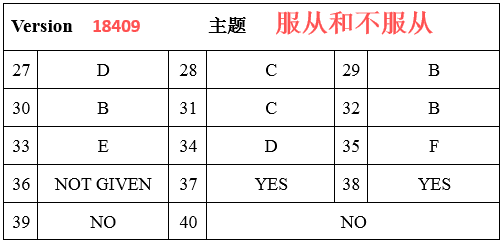GRE阅读怎么提高阅读质量?今天小编给大家带来了GRE阅读怎么提高阅读质量,希望能够帮助到大家,下面小编就和大家分享,来欣赏一下吧。
GRE阅读怎么勾画文章路线图
解剖文章的第1段;在脑子里面形成一个作者思路图;通览文章时,留意语气词和过渡词;停下来,总结一下文章大意;开始答题。
做GRE阅读时首先解剖文章的第1段。积极主动地解读文章的第1段,阅读时尽量记住作者提出的问题(现象或观点),和一些关于文章内容的概念和词汇,如这篇文章讲的是生物化学,日本企业文化还是黑人运动。文章的论题是什么,作者想说什么?
做GRE阅读时要在脑子里面形成一个作者思路图。在脑子里或者在草稿纸上画一个文章的结构思路题。各个段落的目的是什么,主题又是什么?再次提醒,GMAT考察的是你的答题能力而非阅读能力。你不必完全掌握整篇文章,了解文章中的每一个细节。(其实,你也没有那么多时间)。相反,你应该只读文章段落的第1句,而快速浏览其余部分。当你“读”完这篇文章时,你就能对文章的结构思路有总体的把握。
GRE阅读通览文章时,留意语气词和过渡词。在快速阅读文章时,特别留意段落开头或者结尾可能出现的语气词和过渡词。这样做有助于你对作者思路的把握,从而快速掌握文章大意。
接下来停下来总结一下文章大意,在回答问题前,花几秒钟总结一下文章的思路和主题。
最后,开始答题。根据你对文章的整体思路来答题。将问题(或选项)定位到文章中具体的某个段落甚至具体的句子。这里,你可以比第3个步骤更仔细。
GRE阅读材料练习:一起走进神秘的恐龙时代
WORKING out how an extinct animal behaved when it was alive is tricky.
对于灭绝的生物来说,要研究出它们存活时的行为是很棘手,
But it is not always impossible,
不过也不是完全不可能。
as Joseph Peterson and Collin Dischler of the University of Wisconsin
explained on October 17th to the Society of Vertebrate Palaeontology meeting
held in Raleigh, North Carolina.
10月17日,在北卡罗莱纳州罗利市举行的古脊椎动物学会议上,美国威斯康星大学的约瑟夫·彼得森和柯林·狄斯勒就对肿头龙的习性做出了一些解释。
Pachycephalosaurs lived 65m years ago.
肿头龙生活在6500万年前。
As their name suggests, they had large, bony, domed heads.
正如其名称所说,它们有巨大的、高隆的头骨。
For years, it was assumed they used these to bash one another in the way
that rams do now.
多年来,人们一直认为肿头龙用头攻击同类,就像现在的公羊一样。
Recently, though, a second suggestion has surfaced—that rather than for
fighting, the domes were for show; the dinosaur equivalent of a peacock's
tail.
不过最近有人提出另外一个假设:它们的大脑袋不是为了战斗,而是出于展示的目的—作用相当于孔雀的尾巴。
Dr Peterson and Dr Dischler put these two theories into a head-to-head
competition.
彼得森和狄斯勒博士让这两种理论来了个头对头的正面对抗。
To do so, they studied 102 pachycephalosaur skulls, of various species.
为此,他们研究了102只不同品种肿头龙的头骨。
They found that 23 of these skulls had pits in them, and that these pits
were similar both to each other and to those found in the skulls of living
animals that bash each other with their heads.
他们发现其中23只头骨上有凹坑。这些凹坑彼此类似。而且现存的用头部撞击同类的动物中,头骨上的凹坑也与之类似。
That supported the head-butting theory. The clincher, though, came when
they created computerised models of pachycephalosaur skulls and mapped the
damage from each of their pitted specimens on to these virtual skulls.
这支持了头部冲撞理论。不过决定性的证据来自于他们用计算机模拟的肿头龙头骨。他们将每个有坑样本的损伤部位标注在虚拟的头骨上。
When they did this, they found that the pits were clustered—exactly as
might be expected if they were the result of animals deliberately aiming at each
other.
这样操作后,他们发现凹坑聚集分布,正如人们假设的那样:是肿头龙故意用头部攻击彼此的结果。
Intriguingly, they found two patterns of clustering.
有意思的是,他们发现凹坑有两种聚集图案。
Those pachycephalosaurs with highly domed heads had pits on both the fronts
and the backs of their skulls.
那些不太隆起的头骨仅在前方有凹坑,而非常高隆的则前后都有。
Those whose domes were lower had them only on the fronts.
这证明了两种肿头龙攻击时的不同。
This suggests the two sorts of animal fought in different ways. Low-domes,
it seems, simply charged at each other. High-domes did that too.
相对低隆的一种似乎仅向对方迎头冲撞。
But they also engaged in head-to-head wrestling of a sort that allowed them
to get behind their opponents'skulls and do damage from the rear, in the way
that modern bison do.
非常高隆的肿头龙除此之外还会采取头对头式摔跤法:能够碰到对方头骨的背部,从后面对彼此造成损伤,好比如今的野牛。
None of which proves that pachycephalosaurs did not strut their stuff with
their domes as well, just as a stag will often show off its antlers before
engaging in combat, in order to give a less well-endowed rival the opportunity
to withdraw.
然而,两种图案都没有否定肿头龙自豪地迈步时也在炫耀他们的大脑袋。成年雄鹿就经常在战斗之前展示它的鹿角,为了使天生劣势的对手借机撤退。
But it does demonstrate that the domes were serious weapons, not mere
fripperies of fashion.
不过这确实证明了高隆的头骨是很厉害的武器,而不仅仅是时髦的矫饰品。
GRE阅读怎么勾画文章路线图
上一篇:2020GRE阅读考试的六大题型
下一篇:返回列表





